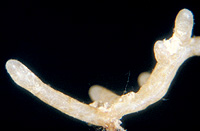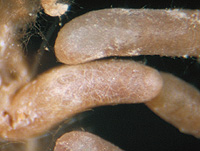

 |
 |
– Enlarged view – |
| • references | |
| Agerer R (1995) Anatomical characteristics of identified ectomycorrhizas: an attempt towards a natural classification. In Varma AK, Hock B (eds.) Mycorrhiza: Structure, function, molecular biology and biotechnology. Springer, Berlin, Heidelberg, pp. 685-734. Giltrap NJ (1979) Experimental studies on the establishment and stability of ectomycorrhizas. PhD thesis, Univ Sheffield. Ingleby K, Mason PA, Last FT, Fleming LV (1990) Identification of ectomycorrhizas. ITE Research Publication no. 5. HMSO, London. |
|
| • length | |
| 0 mm | Lower value of unspecified range (could be µ-s.d., but not known) |
| 10 mm | Upper value of unspecified range (could be µ+s.d., but not known) |
| • ramification presence-type | |
| monopodial-pinnate | |
| • ramification orders | |
| 0 | Lower value of unspecified range (could be µ-s.d., but not known) |
| 1 | Upper value of unspecified range (could be µ+s.d., but not known) |
| • main axis diameter | |
| 0 mm | Lower value of unspecified range (could be µ-s.d., but not known) |
| 0.4 mm | Upper value of unspecified range (could be µ+s.d., but not known) |
| • rhizomorphs as stout, short, conical structures presence-abundance | |
| absent | |
| • rhizomorphs as short mycorrhiza-like outgrowths with blunt tips presence | |
| absent | |
| • rhizomorphs presence | |
| present | |
| • rhizomorphs frequency | |
| infrequent | |
| • shape | |
| bent | |
| or | sinuous |
| or | tortuous |
| • shape {of distal end} | |
| not inflated, cylindric | |
| • colour | |
| brown | |
| or | yellow |
| or | orange |
| or | white |
| • very tip colour | |
| yellowish | |
| • older parts colour | |
| brown | |
| or | yellow |
| or | red |
| • mantle cortical cells visibility | |
| not visible | |
| • mantle {distinct} surface visibility | |
| present | |
| • mantle transparency | |
| not transparent | |
| • mantle laticifers visibility | |
| present | |
| • mantle dots presence-colour | |
| absent | |
| • mantle carbonizing presence | |
| absent | |
| • mantle surface {in general} habit | |
| shiny | |
| • emanating hyphae presence | |
| absent | |
| • diameter | |
| 0 mm | Lower value of unspecified range (could be µ-s.d., but not known) |
| 0.2 mm | Upper value of unspecified range (could be µ+s.d., but not known) |
| • cross-section shape | |
| round or roundish | |
| • colour | |
| concolourous to mantle | |
| • ramification kind-frequency | |
| frequently, at restricted points | |
| • origin location | |
| proximal | |
| • margin habit | |
| smooth | |
| • presence | |
| absent | |
| • emanating elements presence-type | |
| rhizomorphs | |
| • presence | |
| present | |
| • location | |
| outer mantle layer | |
| or | rhizomorphs |
| • shape | |
| straight and even | |
| • ramification presence-abundance | |
| abundant | |
| • cell diameter | |
| 0 µm | Lower value of unspecified range (could be µ-s.d., but not known) |
| 8 µm | Upper value of unspecified range (could be µ+s.d., but not known) |
| • organisation | |
| plectenchymatous | |
| • mantle type | |
| gelatinous matrix between the hyphae (type C) | |
| • septa clamps presence | |
| absent | |
| • cell diameter | |
| 2 µm | Lower value of unspecified range (could be µ-s.d., but not known) |
| 5 µm | Upper value of unspecified range (could be µ+s.d., but not known) |
| • cell wall surface habit | |
| smooth | |
| • organisation | |
| pseudoparenchymatous | |
| • hyphae arrangement | |
| plectenchymatous, without pattern | |
| • cell diameter | |
| 0 µm | Lower value of unspecified range (could be µ-s.d., but not known) |
| 10 µm | Upper value of unspecified range (could be µ+s.d., but not known) |
| • cell length | |
| 0 µm | Lower value of unspecified range (could be µ-s.d., but not known) |
| 15 µm | Upper value of unspecified range (could be µ+s.d., but not known) |
| • cell wall surface habit | |
| smooth | |
| • organisation | |
| plectenchymatous | |
| • hyphae arrangement | |
| without pattern | |
| • septa clamps presence | |
| absent | |
| • cell diameter | |
| 2 µm | Lower value of unspecified range (could be µ-s.d., but not known) |
| 5 µm | Upper value of unspecified range (could be µ+s.d., but not known) |
| • mantle thickness {apart from tip} | |
| 10 µm | Lower value of unspecified range (could be µ-s.d., but not known) |
| 35 µm | Upper value of unspecified range (could be µ+s.d., but not known) |
| • presence | |
| present | |
| • kind | |
| paraepidermal | |
| • anatomy mantle cross-section hyphal cells around cortical (epidermal) cells thickness | |
| 2.5 µm | Lower value of unspecified range (could be µ-s.d., but not known) |
| 12 µm | Upper value of unspecified range (could be µ+s.d., but not known) |
| • structure {in plan view} | |
| infrequently lobed | |
| • clamps presence | |
| absent | |
| • type | |
| undifferentiated; margins rather smooth; hyphae compactly arranged and of uniform diameter (type B) |
|
| • internal nodia presence | |
| absent | |
| • reaction with toluidin blue presence | |
| present | |
| • geographic occurrence continent | |
| Europe | |
| • plant family | |
| Betulaceae | |
| • plant genus | |
| Betula | |
| • plant habitat kind | |
| nursery | |
| or | forests, woods |
| • family | |
| Russulaceae | |
| • subgenus-section | |
| Lactarius sect. Lactarius | |
| • fruitbodies growth habit | |
| epigeous | |
| or | pileate-lamellate |
| • public notes | |
| Mycorrhizal ends yellowish white to brownish orange; Hartig net penetrated to about a half of the epidermis. | |